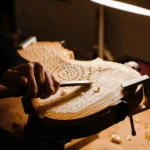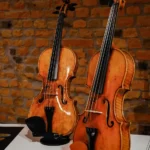A Brief History Lesson: Baroque Period Music
Back to BlogEvery violin lover praise getting to know about music and learning! There are the classical, romantic, and modern periods and today we are going through the Baroque period music. A very important one and in which great composers that we still love nowadays, emerged.
This composition period has its own charm. That’s why we brought some information for you to know who the Baroque composers were, what made their compositions famous, and their characteristics.
The Baroque Period Music
The Baroque era began around 1600 and ended around 1750, and it was a time of great musical innovation. Composers like Bach, Vivaldi, and Handel pioneered new styles like the concerto and the sonata.
It spread throughout Europe during the 1600s, and although it originated in Italy, the style spread to Germany, France, and England over the course of that century. Many theorists believe it took hold in these places because the Renaissance had already progressed their countries to a certain degree, whether it be politically or musically.
At this point, the Church’s political control over Europe was weakening, which meant a time for non-religious music to flourish. It was also when the first idea of modern orchestras started to appear. Although the concerto was the main type of instrumental music during the Baroque period music, Corelli and Vivaldi suit as examples here.
Opera spread to France and England, bringing composers like Rameau, Handel and Purcell. Giving it a boost to these artists as a platform to illustrate emotions in their music; affecting the listener’s feelings became a major objective in composition.
The movement was coming all over Europe and from all kinds of art, but in the music scenario, each country had its contribution.
Italy was at the center, the Italian composers from Rome were non-stop and their compositions were rooted in the Renaissance but at the same time expanded to harmonic and ornamental boundaries.
Alessandro Scarlatti, Domenico Scarlatti, Antonio Corelli and Claudio Monteverdi were among the most notable Italian Baroque composers. Italian composer Antonio Vivaldi was the last major Italian Baroque composer. He worked in the later Baroque era, overlapping with George Frideric Handel and Johann Sebastian Bach.
While traveling, musicians would get influences from the places they had been by adding new elements and styles. German composers such as Georg Philipp Telemann, Michael Praetorius, Johann Pachelbel, and most of all Johann Sebastian Bach helped define the high Baroque period. Another prominent German was George Frideric Handel, although he spent nearly his entire career in England.
Some strong characteristics of this period:
During the Baroque era, the primary keyboard instrument was the pianoforte, an early version of the piano. It replaced the harpsichord.
One of the main differences between them is that the pianoforte strikes strings with felted hammers, whereas the harpsichord plucks strings. This means the pianoforte can play both soft and loud. Instruments like the trumpet and violin emerged during this period, along with the valveless trumpet and the violin. As a result of their dynamic potential, they eclipsed lutes as well.
The Basso continuo (a form of music notation that includes a complete bass line, usually played by a cello in a Baroque ensemble) became popular. Working like this: a keyboard instrument like a harpsichord or piano is played, and the player improvises chords using figured bass notation. Solo organ players often play basso continuo notation entirely on their own.
After Bach’s death in 1750, the Baroque period ended. In the second half of the eighteenth century and early nineteenth century, composers like Mozart and Haydn built on the foundation laid by Baroque composers with their own Classical period.
Bach is considered to be one of the greatest geniuses in the history of music and of this period. His compositions continue to influence harmony in music today. Despite that, there were many other artists in the Baroque period other than Vivaldi and Bach.
Francesca Caccini (1587-1640) was one of them. Daughter of Renaissance master Giulio Caccini, was a singer and lutenist who was one of the most influential women composers in Europe in her day. Her opera La liberazione di Ruggiero has gone down in history as the first ever written by a woman.
George Frederic Handel (1685-1759). Handel’s music for all occasions—including the ‘Hallelujah’ chorus from the Messiah oratorio (Christmas) and Music for the Royal Fireworks (Guy Fawkes Night)—is still popular today.
Giovanni Battista Pergolesi (1710-1736). His life ended tragically early, but he was famous both as a Baroque comic opera composer and for writing an eye-watering beautiful Stabat Mater setting, a sacred piece commissioned for an annual Good Friday service in honor of the Virgin Mary.









